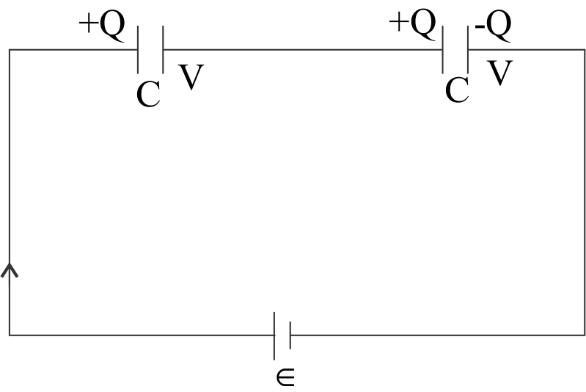
Two capacitors each having a capacitor $C$ and breakdown voltage $V$ are joined in series. The effective capacitance and maximum working voltage of the combination is:
(A) $2C,2V$
(B) $\dfrac{C}{2},\dfrac{V}{2}$
(C) $2C,V$
(D) \[\dfrac{C}{2},2V\]
Answer
217.2k+ views
Hint: We know for a given capacitor, charge \[Q\] on a capacitor is proportional to potential difference \[V\], between the plates.
\[Q = CV\]
And, for series combination charges on capacitors remain the same.
Complete Step by Step Answer
Figure, shows two capacitors connected in series. The capacitance is \[C\] and \[C\].

Now, let us take the potential of the right plate of the second plate to be zero. The potential of the left plate of the first capacitor is \[E\]. Since, the breakdown voltage of capacitors is \[V\]. Therefore capacitor \[1\],
\[E - V = \dfrac{Q}{C}...........(i)\]
Similarly, for other capacitor,
\[V - 0 = \dfrac{Q}{C}...........(ii)\]
Adding equation \[(i)\] and \[(ii)\]
\[E = Q\left( {\dfrac{1}{C} + \dfrac{1}{C}} \right)\,.........\,(iii)\]
If the equivalent capacitance of the combination is \[{C_{eq}}\].
\[{C_{eq}} = \dfrac{Q}{E}\,..........\,(iv)\]
Using equation \[(iii)\] and \[(iv)\] we get,
\[{C_{eq}} = \dfrac{C}{2}\,\]
And, the maximum working voltage is \[E\].
Hence, \[E = V + V = 2V\]
Hence, Option (D) is correct
Note:
Charge on series combination remains same but voltage changes with respect to the capacitance whereas voltage on parallel combination remains same but charge varies in accordance to capacitance.
\[Q = CV\]
And, for series combination charges on capacitors remain the same.
Complete Step by Step Answer
Figure, shows two capacitors connected in series. The capacitance is \[C\] and \[C\].

Now, let us take the potential of the right plate of the second plate to be zero. The potential of the left plate of the first capacitor is \[E\]. Since, the breakdown voltage of capacitors is \[V\]. Therefore capacitor \[1\],
\[E - V = \dfrac{Q}{C}...........(i)\]
Similarly, for other capacitor,
\[V - 0 = \dfrac{Q}{C}...........(ii)\]
Adding equation \[(i)\] and \[(ii)\]
\[E = Q\left( {\dfrac{1}{C} + \dfrac{1}{C}} \right)\,.........\,(iii)\]
If the equivalent capacitance of the combination is \[{C_{eq}}\].
\[{C_{eq}} = \dfrac{Q}{E}\,..........\,(iv)\]
Using equation \[(iii)\] and \[(iv)\] we get,
\[{C_{eq}} = \dfrac{C}{2}\,\]
And, the maximum working voltage is \[E\].
Hence, \[E = V + V = 2V\]
Hence, Option (D) is correct
Note:
Charge on series combination remains same but voltage changes with respect to the capacitance whereas voltage on parallel combination remains same but charge varies in accordance to capacitance.
Recently Updated Pages
Wheatstone Bridge Explained: Working, Formula & Uses

Young’s Double Slit Experiment Derivation Explained

JEE Atomic Structure and Chemical Bonding important Concepts and Tips

JEE Amino Acids and Peptides Important Concepts and Tips for Exam Preparation

Electricity and Magnetism Explained: Key Concepts & Applications

Chemical Properties of Hydrogen - Important Concepts for JEE Exam Preparation

Trending doubts
JEE Main 2026: Application Form Open, Exam Dates, Syllabus, Eligibility & Question Papers

Derivation of Equation of Trajectory Explained for Students

Hybridisation in Chemistry – Concept, Types & Applications

Understanding the Angle of Deviation in a Prism

Understanding Collisions: Types and Examples for Students

How to Convert a Galvanometer into an Ammeter or Voltmeter

Other Pages
JEE Advanced Marks vs Ranks 2025: Understanding Category-wise Qualifying Marks and Previous Year Cut-offs

Understanding Atomic Structure for Beginners

Ideal and Non-Ideal Solutions Explained for Class 12 Chemistry

Degree of Dissociation: Meaning, Formula, Calculation & Uses

Understanding Electromagnetic Waves and Their Importance

Understanding the Electric Field of a Uniformly Charged Ring




